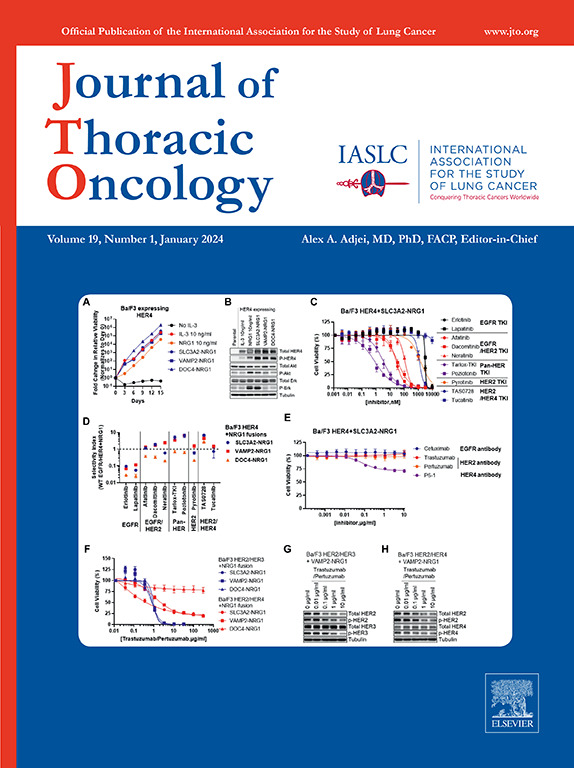在约克郡肺筛查试验中肺癌筛查资格标准和肺癌检测的前瞻性评价。
IF 21
1区 医学
Q1 ONCOLOGY
引用次数: 0
摘要
低剂量CT (LDCT)筛查肺癌可降低肺癌死亡率,但对于筛查的最佳资格标准缺乏国际共识。约克郡肺筛查试验(YLST)旨在评估肺癌筛查(LCS)的实施,主要目标是对3个预先定义的资格标准进行前瞻性评估。方法:接受书面邀请的55-80岁有吸烟史的个体,接受电话风险评估,如果符合至少一项标准(PLCOM2012≥1.51%,LLPv2≥5%,USPSTF2013),则进行两年一次的LDCT筛查。结果:在受邀的44,957人中,有22,814人回应并进行了资格评估,其中共有7,826人符合LCS三个标准中的任何一个标准。比较PLCOM2012≥1.51%、LLPv2≥5%和USPSTF2013,符合筛查条件的应答者比例分别为28.0%、20.5%和18.9% (pM2012(74.5%)和LLPv2(71.3%)高于USPSTF2013 (62.8%) (p=0.0002和p=0.032),但两种风险模型之间无显著差异。将LLPv2风险阈值从5%降低到2.5%(目前在英国肺癌筛查项目中使用),并降低USPSTF2021与USPSTF2013标准的包年要求,增加了符合筛查条件的人数,但随后的癌症产量未在本研究中测量。结论:与LLPv2≥5%或USPSTF2013相比,PLCOM2012≥1.51%的标准确定了更多符合YLST筛查条件的人群,并且导致了更多筛查检测到的肺癌。当在同等人群中进行比较时,在肺癌检测方面,风险模型之间没有显著差异,并且在筛查人群选择方面,每种模型都比USPSTF2013更有效。本文章由计算机程序翻译,如有差异,请以英文原文为准。

Prospective Evaluation of Lung Cancer Screening Eligibility Criteria and Lung Cancer Detection in the Yorkshire Lung Screening Trial
Introduction
Low-dose computed tomography screening for lung cancer reduces lung cancer mortality, but there is a lack of international consensus regarding the optimal eligibility criteria for screening. The Yorkshire Lung Screening Trial was designed to evaluate lung cancer screening (LCS) implementation, and a primary objective was prospective evaluation of three predefined eligibility criteria.
Methods
Individuals who had ever smoked, aged 55 to 80 years, who responded to written invitation, underwent telephone risk assessment and if eligible by at least one criterion (PLCOM2012 ≥ 1.51%, LLPv2 ≥ 5%, USPSTF2013) were offered biennial low-dose computed tomography screening.
Results
Of 44,957 individuals invited, 22,814 responded and underwent eligibility assessment, of whom a total of 7826 were eligible according to any of the three LCS criteria. Comparing PLCOM2012 ≥ 1.51%, LLPv2 ≥ 5%, and USPSTF2013, the proportions of responders eligible for screening were 28.0%, 20.5%, and 18.9%, respectively (p < 0.0001 for each comparison), and the proportion of all cancers detected 91.1%, 77.0%, and 62.8%, respectively (p ≤ 0.0002 for each comparison). When risk thresholds were selected to result in equivalent numbers of people eligible for screening, cancer detection proportions were higher for PLCOM2012 (74.5%) and LLPv2 (71.3%) than USPSTF2013 (62.8%) (p = 0.0002 and p = 0.032, respectively), but there was no significant difference between the two risk models. Reducing the LLPv2 risk threshold from 5% to 2.5% (as currently used in the English LCS program) and reducing the pack-year requirement for the USPSTF2021 versus the USPSTF2013 criteria increased the numbers eligible for screening, but subsequent cancer yield was not measured in this study.
Conclusion
The PLCOM2012 ≥ 1.51% criteria identified more people eligible for screening in Yorkshire Lung Screening Trial and resulted in more screen-detected lung cancers than LLPv2 ≥ 5% or USPSTF2013. When compared in equivalent populations, there was no significant difference between risk models in terms of lung cancer detection and each appeared more efficient at screening population selection than USPSTF2013.
求助全文
通过发布文献求助,成功后即可免费获取论文全文。
去求助
来源期刊

Journal of Thoracic Oncology
医学-呼吸系统
CiteScore
36.00
自引率
3.90%
发文量
1406
审稿时长
13 days
期刊介绍:
Journal of Thoracic Oncology (JTO), the official journal of the International Association for the Study of Lung Cancer,is the primary educational and informational publication for topics relevant to the prevention, detection, diagnosis, and treatment of all thoracic malignancies.The readship includes epidemiologists, medical oncologists, radiation oncologists, thoracic surgeons, pulmonologists, radiologists, pathologists, nuclear medicine physicians, and research scientists with a special interest in thoracic oncology.
 求助内容:
求助内容: 应助结果提醒方式:
应助结果提醒方式:


